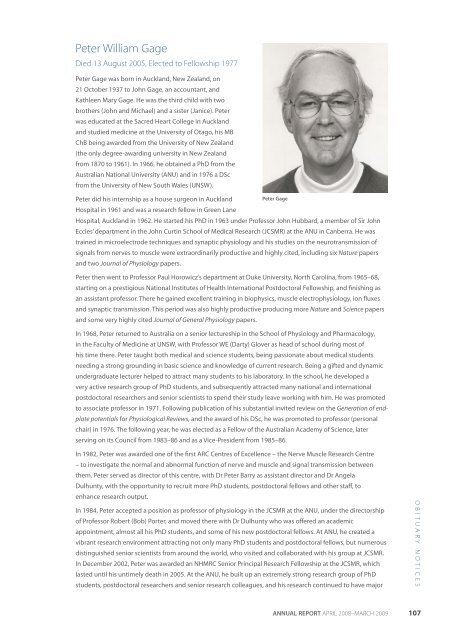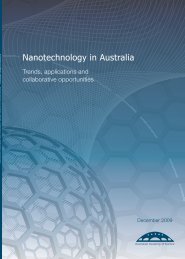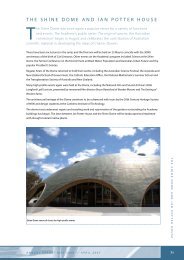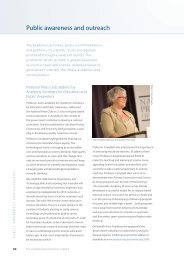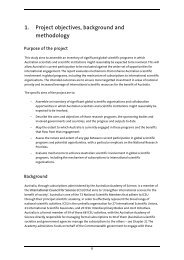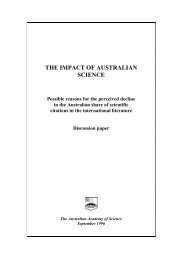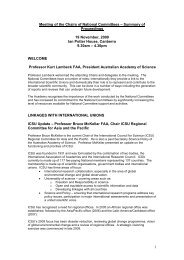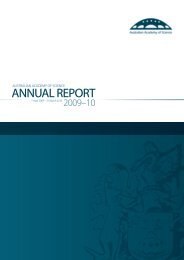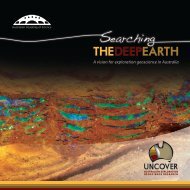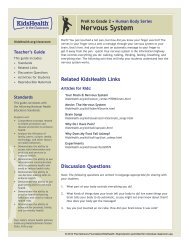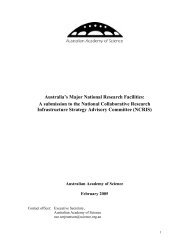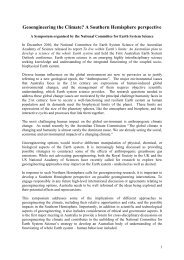full report - Australian Academy of Science
full report - Australian Academy of Science
full report - Australian Academy of Science
You also want an ePaper? Increase the reach of your titles
YUMPU automatically turns print PDFs into web optimized ePapers that Google loves.
Peter William Gage<br />
Died 13 August 2005, Elected to Fellowship 1977<br />
Peter Gage was born in Auckland, New Zealand, on<br />
21 October 1937 to John Gage, an accountant, and<br />
Kathleen Mary Gage. He was the third child with two<br />
brothers (John and Michael) and a sister (Janice). Peter<br />
was educated at the Sacred Heart College in Auckland<br />
and studied medicine at the University <strong>of</strong> Otago, his MB<br />
ChB being awarded from the University <strong>of</strong> New Zealand<br />
(the only degree-awarding university in New Zealand<br />
from 1870 to 1961). In 1966, he obtained a PhD from the<br />
<strong>Australian</strong> National University (ANU) and in 1976 a DSc<br />
from the University <strong>of</strong> New South Wales (UNSW).<br />
Peter did his internship as a house surgeon in Auckland<br />
Hospital in 1961 and was a research fellow in Green Lane<br />
Peter Gage<br />
Hospital, Auckland in 1962. He started his PhD in 1963 under Pr<strong>of</strong>essor John Hubbard, a member <strong>of</strong> Sir John<br />
Eccles’ department in the John Curtin School <strong>of</strong> Medical Research (JCSMR) at the ANU in Canberra. He was<br />
trained in microelectrode techniques and synaptic physiology and his studies on the neurotransmission <strong>of</strong><br />
signals from nerves to muscle were extraordinarily productive and highly cited, including six Nature papers<br />
and two Journal <strong>of</strong> Physiology papers.<br />
Peter then went to Pr<strong>of</strong>essor Paul Horowicz’s department at Duke University, North Carolina, from 1965–68,<br />
starting on a prestigious National Institutes <strong>of</strong> Health International Postdoctoral Fellowship, and finishing as<br />
an assistant pr<strong>of</strong>essor. There he gained excellent training in biophysics, muscle electrophysiology, ion fluxes<br />
and synaptic transmission. This period was also highly productive producing more Nature and <strong>Science</strong> papers<br />
and some very highly cited Journal <strong>of</strong> General Physiology papers.<br />
In 1968, Peter returned to Australia on a senior lectureship in the School <strong>of</strong> Physiology and Pharmacology,<br />
in the Faculty <strong>of</strong> Medicine at UNSW, with Pr<strong>of</strong>essor WE (Darty) Glover as head <strong>of</strong> school during most <strong>of</strong><br />
his time there. Peter taught both medical and science students, being passionate about medical students<br />
needing a strong grounding in basic science and knowledge <strong>of</strong> current research. Being a gifted and dynamic<br />
undergraduate lecturer helped to attract many students to his laboratory. In the school, he developed a<br />
very active research group <strong>of</strong> PhD students, and subsequently attracted many national and international<br />
postdoctoral researchers and senior scientists to spend their study leave working with him. He was promoted<br />
to associate pr<strong>of</strong>essor in 1971. Following publication <strong>of</strong> his substantial invited review on the Generation <strong>of</strong> endplate<br />
potentials for Physiological Reviews, and the award <strong>of</strong> his DSc, he was promoted to pr<strong>of</strong>essor (personal<br />
chair) in 1976. The following year, he was elected as a Fellow <strong>of</strong> the <strong>Australian</strong> <strong>Academy</strong> <strong>of</strong> <strong>Science</strong>, later<br />
serving on its Council from 1983–86 and as a Vice-President from 1985–86.<br />
In 1982, Peter was awarded one <strong>of</strong> the first ARC Centres <strong>of</strong> Excellence – the Nerve Muscle Research Centre<br />
– to investigate the normal and abnormal function <strong>of</strong> nerve and muscle and signal transmission between<br />
them. Peter served as director <strong>of</strong> this centre, with Dr Peter Barry as assistant director and Dr Angela<br />
Dulhunty, with the opportunity to recruit more PhD students, postdoctoral fellows and other staff, to<br />
enhance research output.<br />
In 1984, Peter accepted a position as pr<strong>of</strong>essor <strong>of</strong> physiology in the JCSMR at the ANU, under the directorship<br />
<strong>of</strong> Pr<strong>of</strong>essor Robert (Bob) Porter, and moved there with Dr Dulhunty who was <strong>of</strong>fered an academic<br />
appointment, almost all his PhD students, and some <strong>of</strong> his new postdoctoral fellows. At ANU, he created a<br />
vibrant research environment attracting not only many PhD students and postdoctoral fellows, but numerous<br />
distinguished senior scientists from around the world, who visited and collaborated with his group at JCSMR.<br />
In December 2002, Peter was awarded an NHMRC Senior Principal Research Fellowship at the JCSMR, which<br />
lasted until his untimely death in 2005. At the ANU, he built up an extremely strong research group <strong>of</strong> PhD<br />
students, postdoctoral researchers and senior research colleagues, and his research continued to have major<br />
OBITUARY NOTICES<br />
ANNUAL REPORT APRIL 2008–MARCH 2009 107


